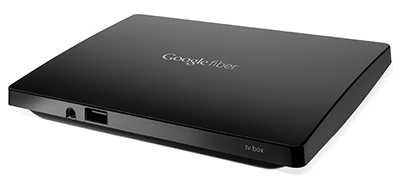Google Fiber TV Bets on Blistering Broadband

Google Fiber TV Box
MOUNTAIN VIEW, CALIF. — Comcast, Cox, Cablevision, Time Warner, Verizon FiOS, Google—all are signing up customers for cable TV programming and Internet service. Yes, Google is rolling out a cable TVlike service that it calls “Google Fiber TV.”
At the moment, Google’s home offering is skewed somewhat more toward Internet service than traditional television programming, but the service will deliver its share of entertainment channels. However, the real eye-opening part of the Google Fiber TV package is the promised broadband data speed to the home: 1 Gbps for both upload and download. That’s 1 Gbps each, not combined.
“That is 100 times faster than today’s average broadband speed,” said Jenna Wandress, a spokeswoman for Google. “And the cost will be $70 per month.”
For those who don’t want to pony up for neck-snapping data speeds and Google’s programming package, they can get free data service from Google. For the price of installation and equipment, Google will offer its customers a 5 Mbps data service for free, for up to several years. That’s right—if you pay the $300 construction fee (covering the fiber-to-the-home drop and residential equipment), you get free Internet service that should average 5 Mbps.
If you’re like most people, this sounds great… so where can you sign up?
Unless you live in Kansas City (both Kansas and Missouri), you can’t—not yet, anyway. Kansas City is the first market for Google Fiber TV and, as of this writing, the physical cabling plant for the service is about half complete. Google has organized potential customers by neighborhood, which Google calls “fiberhoods.” According to Wandress, 111 out of 202 fiberhoods are currently qualified for service.
Get the TV Tech Newsletter
The professional video industry's #1 source for news, trends and product and tech information. Sign up below.
The Google service was launched in late-July with a 60-day “Google Fiber Rally.” By the end of August, about 50 percent of the fiberhoods in the Kansas City area had reached their pre-registration goals, according to tech blog Techcrunch.
NETWORK TOPOLOGY
Google has been quiet about the network topology for Google Fiber TV.
“The information that I have been able to find does not definitively indicate whether Google Fiber TV is a passive optical network [PON] or Active Ethernet,” said Wes Simpson, president of Telecom Product Consulting in Orange Conn., who also pens the TV Technology’s bi-monthly column “Video Networking.” “Both networks are completely passive, in that all of the electronics are either at the provider’s facility or at the subscriber’s home, and only fiber runs in the outside plant. This is of tremendous benefit for reliability, since there is no need to have electronics cabinets in the field that might have environmental controls, power requirements and telemetry data.”

Google recently built the “Google Fiber Space” in Kansas City to promote its new service.
Simpson said that, despite the advertised data speed, there’s no great leap in Google’s technology.
“I think the only thing that Google is doing uniquely is using a higher-speed PON technology than other providers [such as Verizon FiOS] have been deploying,” he said. “They could, for example, be using XG-PON standards that can provide 10 Gbps aggregate bandwidth in both directions. Of course, if they are using Active Ethernet, that would be unique for home deployment in the US.”
Google’s network structure has ramifications for its pay-TV distribution.
“Google appears to be offering a pure-play IPTV network, like AT&T U-Verse but unlike Verizon FiOS, which used 256QAM broadcast for many TV channels,” Simpson said. “This means that Google will be deploying some pretty hefty routers in its office to support multicasting to thousands of simultaneous viewers for popular channels.”
Google is secretive about its source for the gear being used for Google Fiber TV. However, a year ago, the company purchased the telecom products side of Motorola and it’s reasonable to assume that is where at least some of the equipment will be sourced. A Google spokesman simply said that company builds its own devices.
There is an interesting array of devices that will come with a programming package, including three boxes for the home: the TV Box, the Network Box and the Storage Box. All three will be needed with a full programming package, but all are significantly smaller than the typical cable set-top box. As for the Storage Box, it has 2 TB of storage— enough for 500 hours of HD recording.
In addition to the necessary boxes, Google Fiber TV will come with a Google Nexus 7 tablet that will be used as the system’s remote control. Since the Nexus 7 runs the Android operating system and Google developed Android, it’s quite likely that at least some Android phones could be used to control Google Fiber TV.
WHERE’S THE PROGRAMMING?
Just what programming will be offered by Google TV has been a subject of discussion. It’s no secret that Google has been struggling to line up many popular networks, such as HBO and ESPN. (Google has a list of channels and networks on its web site at http://fiber.google.com/plans/residential.) One recent deal announced earlier this month was a multi-year agreement to carry the NFL Network and NFL RedZone channels on an a la carte basis.
“We are currently in talks with some content providers that aren’t listed on the channel line-up, and hope to have an announcement soon,” Wandress said.
Industry observers are quite mixed on significance of Google’s Fiber TV effort.
“From a consumer standpoint, it’s a pretty confusing offering,” said Bruce Leichtman, president and principal analyst for the Leichtman Research Group in Durham, N.H. “Google talks about all this high-tech HD and the ability to record eight programs at once, but they’re missing six of the top-10 cable networks. The other thing they don’t have is a phone service.”
Leichtman said that the system’s design limits its geographic growth.
“Google is actually building a [fiber] plant, which makes it highly unlikely that this will continue much further than Kansas City,” he said. “This is really a test.”
For this reason, Leichtman thinks that Google’s competitors aren’t too concerned about any other cities beyond Kansas City. And even in Kansas City, he has doubts about the competitiveness of the package Google is offering.
“Yes, it’s a very high-speed Internet service— which there’s no demand for—but from a competitive standpoint against Time Warner in Kansas City, it’s not all there,” Leichtman said.
Still, Internet speeds of 1 Gbps and a reasonable mix of entertainment channels for $70 a month (including DVR capability) could be a siren song for many consumers. Others, particularly people on fixed incomes, may be very attracted by the reasonable upfront cost to get free 5 Mbps Internet service, as that is a perfectly good speed for email, online shopping and swapping photos of the grandkids.
How loud and sweet that siren song is may boil down to something as simple as your e-mail address. If you use your cable/ Internet provider for your e-mail, you may find it difficult to switch to Google and lose your Comcast, Verizon, Time Warner or Cablevision address.
However, for those who can switch, Google Fiber TV will soon be an option in Kansas City. Whether it turns out to be a local experiment or a significant new nationwide competitor won’t be known for at least several months.
Bob Kovacs is the former Technology Editor for TV Tech and editor of Government Video. He is a long-time video engineer and writer, who now works as a video producer for a government agency. In 2020, Kovacs won several awards as the editor and co-producer of the short film "Rendezvous."

